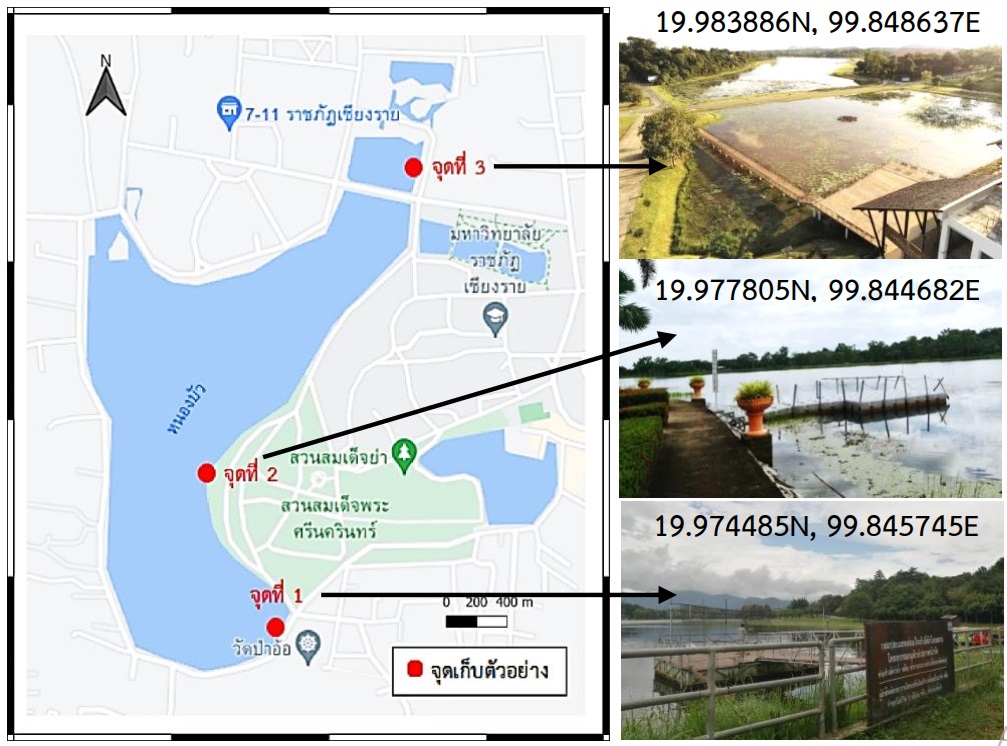Assessment of Water Quality, Trophic Status and Carbon Dioxide Captured by Biomass Producers in the Lentic Ecosystem of Chiang Rai Rajabhat University
Main Article Content
Abstract
The objective of this study was to investigate water quality, trophic status, and assess the CO2 capture by biomass producers. Water samples were collected using grab sampling from
three sampling sites and five times in Nong Bua of Chiang Rai Rajabhat University area during August-September 2021, and subsequently examined for physico-chemical water quality, Net primary Productivity (NPP) and CO2 captured. The trophic status of water sources was evaluated, and the relationship between Sechi transparency, nutrients, and CO2 capture by biomass producers was analyzed. The examined of the physico-chemical properties of water indicated that the water quality index predominantly aligns with established criteria for type 2 surface water. The mean NPP was 233.46±200.97 mgC·m-2·day-1, whereas the biomass producers captured an average of 856.80±737.57 mgC·m-2·day-1 of CO2. Furthermore, the assessment based on Trophic State Index (TSI), which take into account total phosphorus, indicated that all water sources were in a hypereutrophic, whereas an assessment based on TSI measurements of Sechi transparency values classed all water sources as eutrophic. The regression analysis revealed significant relationships (p < 0.001) between CO2 capture and the total phosphorus, nitrate nitrogen, and Sechi transparency.
Article Details
References
ชีระวิทย์ รัตนพันธ์. 2548. การกำจัดฟอสฟอรัสในน้ำเสียโดยใช้เถ้าลอยจากเตาเผาขยะภูเก็ต. ปริญญานิพนธ์วิทยาศาสตรบัณฑิต มหาวิทยาลัยสงขลานครินทร์. สงขลา.
วรพงศ์ ฤกษ์เกลี้ยง. 2558. ผลกระทบจากการเปลี่ยนแปลงของฝนต่อการชะล้างไนโตรเจนและฟอสฟอรัสในลุ่มน้ำคลองอู่ตะเภาตอนบนโดยใช้แบบจำลอง SWAT. ปริญญานิพนธ์วิทยาศาสตรบัณฑิต จุฬาลงกรณ์มหาวิทยาลัย. กรุงเทพฯ.
ศิรัจชญา ตาสติ และ อนุกูล จิตชัยเจริญกุล. 2548. การวิเคราะห์คุณภาพน้ำหนองบัวใหญ่และหนองบัวน้อยโดยใช้ปัจจัยทางด้านกายภาพเคมีและชีวภาพบางประการเป็นดัชนีชี้วัดคุณภาพน้ำ. ปริญญานิพนธ์วิทยาศาสตรบัณฑิต มหาวิทยาลัยราชภัฏเชียงราย. เชียงราย
สำนักงานป้องกันและบรรเทาสาธารณภัยจังหวัดเชียงราย. 2563. ข้อมูลสภาพปัญหาและแนวทางการแก้ไขปัญหาเบื้องต้นของตำแหน่งการกีดขวางทางน้ำ จังหวัดเชียงราย. แหล่งข้อมูล: https://blockage.crflood.com/report/pdf/B00261. ค้นเมื่อ 20 สิงหาคม 2563.
Alberta Environmenta. 2006. Aquatic ecosystems field sampling protocol. Edmonton: Alberta Environment.
Baruah, P.P. 2003. Primary productivity status of a reclaimed ox-bow beel of middle assam. Geobios. 30: 49-52.
Carlson, R.E., and J. Simpson. 1996. A coordinator’s guide to volunteer lake monitoring methods. North American Lake Management Society.
Çelekli, A., and Ö Lekesiz. 2021. Limno-ecological assessment of lentic ecosystems in the western Mediterranean basin (Turkey) using phytoplankton indices. Environmental science and pollution research international. 28: 3719–3736.
Costa, J.A.V., G.A. Linde, and D.I.P. Atala. 2000. Modelling of growth conditions for cyanobacterium Spirulina pletensis in microcosm. World Journal of Microbiology and Biotechnology. 16: 15-18.
Greenbreg, A.E., L.S. Clescerri, and A.D. Eaton. 2005. Standard methods for the examination of water and wastewater. 20th Edition. American Public Health Association (APHA).
Guildford, S.J., H.A. Bootsma, W.D. Taylor, and R.E. Hecky. 2007. High variability of phytoplankton photosynthesis in response to environmental forcing in oligotrophic lake Malawi/Nyasa. Journal of Great Lakes Research. 33: 170-185.
Hiroki, M., N. Tomioka, T. Murata, A. Imai, T. Jutagate, C. Preecha, P. Avakul, P. Phomikong, and M. Fukushim. 2020. Primary production estimated for large lakes and reservoirs in the Mekong river basin. Science of the Total Environment. 747: 141133.
Holtgrieve, G.W., M.E. Arias, K.N. Irvine, D. Lamberts, E.J. Ward, M. Kummu, J. Koponen, J. Sarkkula, and J.E. Richey. 2013. Patterns of ecosystem metabolism in the Tonle Sap lake, Cambodia with links to capture fisheries. Plos One. 8: e71395.
Intergovernmental Panel of Climate Change (IPCC). 2014. Climate Change 2014 Synthesis Report Summary for Policy makers. Available: https://www.ipcc.ch/site/assets/uploads/2018/05/SYR_AR5_FINAL_full_wcover.pdf. Accessed Jan. 27, 2024.
Langley, N.M., S.T.L. Harrison, and R.P. Van Hille. 2012. A critical evaluation of CO2 supplementation to algal systems by direct injection. Biochemical Engineering Journal. 68: 70-75.
Lind, O.T. 1985. Handbook of common methods in limnology. 2nd Edition. Kendall/Hunt.
Miller, G.T., and S.E. Spoolman. 2009. Essentials of ecology. 5th Edition. Brooks/Cole.
Pal, R., and A.K. Choudhury. 2014. Phytoplanktons and primary productivity. In: An Introduction to phytoplanktons: Diversity and ecology. Springer.
Phrommarat, B., and D. Buawech. 2020. Assessment of carbon dioxide captured in producer biomass and its influencing factors in a tropical freshwater reservoir. Journal of Food Health and Bioenvironmental Science. 13: 25–33.
QGIS Development Team. 2021. QGIS Geographic Information System. Available: https://qgis.org/en/site/forusers/download.html. Accessed May 14, 2021.
Reich, P.B., J. Knops, D. Tilman, J. Craine, D. Ellsworth, M. Tjoelker, T. Lee, D. Wedin, S. Naeem, D. Bahauddin, G. Hendrey, S. Jose, K. Wrage, J. Goth, and W. Bengston. 2001. Plant diversity enhances ecosystem responses to elevated CO2 and nitrogen deposition. Nature. 410: 809-810.
Singh, A.K., R. Kumari, and A. Kumar. 2018. The contribution of phytoplankton to the primary production in floodplain lakes (chaurs) of north Bihar, India. International Journal of Ecology and Development Research. 4: 44-52.
Sugunan, V.V., and B.K. Bhattacharjya. 2000. Ecology and fisheries of beels in Assam bulletin No. 104. Central Inland Fisheries Research Institute.
Vollenweider, R.A. 1969. A manual on methods for measuring primary production in aquatic environments. Blackwell Scientific.


